Downscale Inversion of Soil Moisture during Vegetation Growth Period in Ebinur Lake Watershed
Abstract
:1. Introduction
2. Materials and Methods
2.1. Study Area Description
2.2. Data
2.3. Modeling of Soil Moisture Downscaling
2.3.1. Water–Cloud Model(WCM)
2.3.2. Inversion of Vegetation Water Content
2.3.3. Geographically and Temporally Weighted Regression (GTWR) Model
2.3.4. Verification of Model Accuracy
2.4. Morlet Wavelet Analysis
2.5. Semi-Variogram
2.6. Trend Analysis
2.6.1. Theil–Sen Trend Analysis
2.6.2. Mann–Kendall Significance Test
3. Result
3.1. Periodic Results of Wavelet Transform
3.2. High-Resolution Soil Moisture Downscaling Results and Accuracy Validation
3.3. Trend Analysis of RSEI in the Aral Sea Basin
3.4. Semi-Variogram Results
4. Discussion
4.1. Applicability of Water–Cloud Model for Extracting Soil Moisture in Arid Zones of Central Asia
4.2. Application and Prospects of GTWR Modeling in Soil Moisture Downscaling
4.3. Characteristics of Spatial Distribution of and Spatiotemporal Changes in Soil Moisture during Vegetation Growth
5. Conclusions
Author Contributions
Funding
Data Availability Statement
Acknowledgments
Conflicts of Interest
Appendix A


Appendix B
| Apr. 2019 | May. 2019 | Jun. 2019 | Jul. 2019 | Aug. 2019 | Sep. 2019 | Oct. 2019 |
|---|---|---|---|---|---|---|
| Moran’s Index: 0.555310 | Moran’s Index: 0.617305 | Moran’s Index: 0.632113 | Moran’s Index: 0.620127 | Moran’s Index: 0.609430 | Moran’s Index: 0.578060 | Moran’s Index: 0.460031 |
| Expected Index: −0.000017 | Expected Index: −0.000017 | Expected Index: −0.000017 | Expected Index: −0.000017 | Expected Index: −0.000017 | Expected Index: −0.000017 | Expected Index: −0.000017 |
| Variance: 0.000009 | Variance: 0.000009 | Variance: 0.000009 | Variance: 0.000009 | Variance: 0.000009 | Variance: 0.000009 | Variance: 0.000009 |
| z-score: 187.484699 | z-score: 208.413339 | z-score: 213.410711 | z-score: 209.361468 | z-score: 205.750481 | z-score: 195.160900 | z-score: 155.314171 |
| p-value: 0.000000 | p-value: 0.000000 | p-value: 0.000000 | p-value: 0.000000 | p-value: 0.000000 | p-value: 0.000000 | p-value: 0.000000 |
| Apr. 2020 | May. 2020 | Jun. 2020 | Jul. 2020 | Aug. 2020 | Sep. 2020 | Oct. 2020 |
|---|---|---|---|---|---|---|
| Moran’s Index: 0.391148 | Moran’s Index: 0.588617 | Moran’s Index: 0.630545 | Moran’s Index: 0.506215 | Moran’s Index: 0.522824 | Moran’s Index: 0.537381 | Moran’s Index: 0.328472 |
| Expected Index: −0.000017 | Expected Index: −0.000017 | Expected Index: −0.000017 | Expected Index: −0.000017 | Expected Index: −0.000017 | Expected Index: −0.000017 | Expected Index: −0.000017 |
| Variance: 0.000002 | Variance: 0.000009 | Variance: 0.000003 | Variance: 0.000001 | Variance: 0.000001 | Variance: 0.000003 | Variance: 0.000002 |
| z-score: 287.362428 | z-score: 191.101476 | z-score: 374.244867 | z-score: 599.596210 | z-score: 528.734597 | z-score: 300.292076 | z-score: 233.940330 |
| p-value: 0.000000 | p-value: 0.000000 | p-value: 0.000000 | p-value: 0.000000 | p-value: 0.000000 | p-value: 0.000000 | p-value: 0.000000 |
| Apr. 2021 | May. 2021 | Jun. 2021 | Jul. 2021 | Aug. 2021 | Sep. 2021 | Oct. 2021 |
|---|---|---|---|---|---|---|
| Moran’s Index: 0.462455 | Moran’s Index: 0.472021 | Moran’s Index: 0.623924 | Moran’s Index: 0.587860 | Moran’s Index: 0.559914 | Moran’s Index: 0.576756 | Moran’s Index: 0.467150 |
| Expected Index: −0.000017 | Expected Index: −0.000017 | Expected Index: −0.000017 | Expected Index: −0.000017 | Expected Index: −0.000017 | Expected Index: −0.000017 | Expected Index: −0.000017 |
| Variance: 0.000009 | Variance: 0.000009 | Variance: 0.000009 | Variance: 0.000009 | Variance: 0.000009 | Variance: 0.000009 | Variance: 0.000009 |
| z-score: 150.258336 | z-score: 153.584843 | z-score: 203.581622 | z-score: 191.291376 | z-score: 182.204237 | z-score: 187.687546 | z-score: 151.987195 |
| p-value: 0.000000 | p-value: 0.000000 | p-value: 0.000000 | p-value: 0.000000 | p-value: 0.000000 | p-value: 0.000000 | p-value: 0.000000 |
| Apr. 2022 | May. 2022 | Jun. 2022 | Jul. 2022 | Aug. 2022 | Sep. 2022 | Oct. 2022 |
|---|---|---|---|---|---|---|
| Moran’s Index: 0.613398 | Moran’s Index: 0.565242 | Moran’s Index: 0.588357 | Moran’s Index: 0.564530 | Moran’s Index: 0.536942 | Moran’s Index: 0.503322 | Moran’s Index: 0.550308 |
| Expected Index: −0.000017 | Expected Index: −0.000017 | Expected Index: −0.000017 | Expected Index: −0.000017 | Expected Index: −0.000017 | Expected Index: −0.000017 | Expected Index: −0.000017 |
| Variance: 0.000010 | Variance: 0.000010 | Variance: 0.000010 | Variance: 0.000010 | Variance: 0.000010 | Variance: 0.000010 | Variance: 0.000010 |
| z-score: 193.145726 | z-score: 177.983687 | z-score: 185.260224 | z-score: 177.757901 | z-score: 169.071400 | z-score: 158.485737 | z-score: 173.280961 |
| p-value: 0.000000 | p-value: 0.000000 | p-value: 0.000000 | p-value: 0.000000 | p-value: 0.000000 | p-value: 0.000000 | p-value: 0.000000 |
| Jun. 2019 | Jul. 2019 | Aug. 2019 | Sep. 2019 | Oct. 2019 |
|---|---|---|---|---|
| Moran’s Index: 0.570170 | Moran’s Index: 0.208791 | Moran’s Index: 0.600034 | Moran’s Index: 0.532076 | Moran’s Index: 0.535009 |
| Expected Index: −0.000018 | Expected Index: −0.000017 | Expected Index: −0.000017 | Expected Index: −0.000017 | Expected Index: −0.000017 |
| Variance: 0.000001 | Variance: 0.000008 | Variance: 0.000009 | Variance: 0.000009 | Variance: 0.000009 |
| z-score: 476.175361 | z-score: 71.782151 | z-score: 202.595467 | z-score: 178.894242 | z-score: 179.849146 |
| p-value: 0.000000 | p-value: 0.000000 | p-value: 0.000000 | p-value: 0.000000 | p-value: 0.000000 |
| Jun. 2020 | Jul. 2020 | Aug. 2020 | Sep. 2020 | Oct. 2020 |
|---|---|---|---|---|
| Moran’s Index: 0.430401 | Moran’s Index: 0.855232 | Moran’s Index: 0.653346 | Moran’s Index: 0.451446 | Moran’s Index: 0.486112 |
| Expected Index: −0.000017 | Expected Index: −0.000017 | Expected Index: −0.000017 | Expected Index: −0.000017 | Expected Index: −0.000017 |
| Variance: 0.000009 | Variance: 0.000009 | Variance: 0.000009 | Variance: 0.000009 | Variance: 0.000009 |
| z-score: 144.642495 | z-score: 287.375989 | z-score: 219.535925 | z-score: 151.845058 | z-score: 163.340634 |
| p-value: 0.000000 | p-value: 0.000000 | p-value: 0.000000 | p-value: 0.000000 | p-value: 0.000000 |
| Jun. 2021 | Jul. 2021 | Aug. 2021 | Sep. 2021 | Oct. 2021 |
|---|---|---|---|---|
| Moran’s Index: 0.313112 | Moran’s Index: −0.000052 | Moran’s Index: 0.903433 | Moran’s Index: 0.000004 | Moran’s Index: 0.389250 |
| Expected Index: −0.000017 | Expected Index: −0.000017 | Expected Index: −0.000017 | Expected Index: −0.000017 | Expected Index: −0.000017 |
| Variance: 0.000009 | Variance: 0.000007 | Variance: 0.000009 | Variance: 0.000000 | Variance: 0.000008 |
| z-score: 106.967782 | z-score: -0.013439 | z-score: 304.001112 | z-score: 1.367924 | z-score: 135.030061 |
| p-value: 0.000000 | p-value: 0.989278 | p-value: 0.000000 | p-value: 0.171336 | p-value: 0.000000 |
| Jun. 2022 | Jul. 2022 | Aug. 2022 | Sep. 2022 | Oct. 2022 |
|---|---|---|---|---|
| Moran’s Index: 0.909025 | Moran’s Index: −0.000003 | Moran’s Index: −0.000004 | Moran’s Index: −0.000005 | Moran’s Index: −0.000002 |
| Expected Index: −0.000017 | Expected Index: −0.000017 | Expected Index: −0.000017 | Expected Index: −0.000017 | Expected Index: −0.000017 |
| Variance: 0.000009 | Variance: 0.000000 | Variance: 0.000000 | Variance: 0.000000 | Variance: 0.000000 |
| z-score: 305.872320 | z-score: 0.737315 | z-score: 0.700506 | z-score: 0.737375 | z-score: 0.924505 |
| p-value: 0.000000 | p-value: 0.460931 | p-value: 0.483611 | p-value: 0.460894 | p-value: 0.355224 |
| Apr. 2019 | May. 2019 | Jun. 2019 | Jul. 2019 | Aug. 2019 | Sep. 2019 | Oct. 2019 |
|---|---|---|---|---|---|---|
| Moran’s Index: 0.518311 | Moran’s Index: 0.434305 | Moran’s Index: 0.492684 | Moran’s Index: 0.618775 | Moran’s Index: 0.582211 | Moran’s Index: 0.474545 | Moran’s Index: 0.585973 |
| Expected Index: −0.000019 | Expected Index: −0.000018 | Expected Index: −0.000018 | Expected Index: −0.000017 | Expected Index: −0.000017 | Expected Index: −0.000017 | Expected Index: −0.000017 |
| Variance: 0.000001 | Variance: 0.000001 | Variance: 0.000001 | Variance: 0.000009 | Variance: 0.000004 | Variance: 0.000003 | Variance: 0.000003 |
| z-score: 627.365178 | z-score: 450.071224 | z-score: 411.551453 | z-score: 201.331395 | z-score: 302.133456 | z-score: 297.222089 | z-score: 350.249157 |
| p-value: 0.000000 | p-value: 0.000000 | p-value: 0.000000 | p-value: 0.000000 | p-value: 0.000000 | p-value: 0.000000 | p-value: 0.000000 |
| Apr. 2020 | May. 2020 | Jun. 2020 | Jul. 2020 | Aug. 2020 | Sep. 2020 | Oct. 2020 |
|---|---|---|---|---|---|---|
| Moran’s Index: 0.435386 | Moran’s Index: 0.319168 | Moran’s Index: 0.430352 | Moran’s Index: 0.855223 | Moran’s Index: 0.653333 | Moran’s Index: 0.451416 | Moran’s Index: 0.486066 |
| Expected Index: −0.000017 | Expected Index: −0.000017 | Expected Index: −0.000017 | Expected Index: −0.000017 | Expected Index: −0.000017 | Expected Index: −0.000017 | Expected Index: −0.000017 |
| Variance: 0.000009 | Variance: 0.000009 | Variance: 0.000009 | Variance: 0.000009 | Variance: 0.000009 | Variance: 0.000009 | Variance: 0.000009 |
| z-score: 146.333002 | z-score: 107.522386 | z-score: 144.625883 | z-score: 287.372927 | z-score: 219.531478 | z-score: 151.835071 | z-score: 163.325003 |
| p-value: 0.000000 | p-value: 0.000000 | p-value: 0.000000 | p-value: 0.000000 | p-value: 0.000000 | p-value: 0.000000 | p-value: 0.000000 |
| Apr. 2021 | May. 2021 | Jun. 2021 | Jul. 2021 | Aug. 2021 | Sep. 2021 | Oct. 2021 |
|---|---|---|---|---|---|---|
| Moran’s Index: 0.694869 | Moran’s Index: 0.218184 | Moran’s Index: 0.313102 | Moran’s Index: −0.000043 | Moran’s Index: 0.903433 | Moran’s Index: 0.000007 | Moran’s Index: 0.389210 |
| Expected Index: −0.000017 | Expected Index: −0.000017 | Expected Index: −0.000017 | Expected Index: −0.000017 | Expected Index: −0.000017 | Expected Index: −0.000017 | Expected Index: −0.000017 |
| Variance: 0.000009 | Variance: 0.000008 | Variance: 0.000009 | Variance: 0.000007 | Variance: 0.000009 | Variance: 0.000000 | Variance: 0.000008 |
| z-score: 234.402345 | z-score: 77.250924 | z-score: 106.964295 | z-score: −0.009995 | z-score: 304.001105 | z-score: 2.311559 | z-score: 135.016083 |
| p-value: 0.000000 | p-value: 0.000000 | p-value: 0.000000 | p-value: 0.992025 | p-value: 0.000000 | p-value: 0.020802 | p-value: 0.000000 |
| Apr. 2022 | May. 2022 | Jun. 2022 | Jul. 2022 | Aug. 2022 | Sep. 2022 | Oct. 2022 |
|---|---|---|---|---|---|---|
| Moran’s Index: 0.000005 | Moran’s Index: 0.000009 | Moran’s Index: 0.909024 | Moran’s Index: 0.000014 | Moran’s Index: 0.000013 | Moran’s Index: 0.000011 | Moran’s Index: 0.000017 |
| Expected Index: −0.000017 | Expected Index: −0.000017 | Expected Index: −0.000017 | Expected Index: −0.000017 | Expected Index: −0.000017 | Expected Index: −0.000017 | Expected Index: −0.000017 |
| Variance: 0.000000 | Variance: 0.000000 | Variance: 0.000009 | Variance: 0.000000 | Variance: 0.000000 | Variance: 0.000000 | Variance: 0.000000 |
| z-score: 1.131797 | z-score: 1.858160 | z-score: 305.871935 | z-score: 2.704971 | z-score: 2.959489 | z-score: 2.830575 | z-score: 2.285628 |
| p-value: 0.257720 | p-value: 0.063146 | p-value: 0.000000 | p-value: 0.006831 | p-value: 0.003081 | p-value: 0.004646 | p-value: 0.022276 |
| Apr. 2019 | May. 2019 | Jun. 2019 | Jul. 2019 | Aug. 2019 | Sep. 2019 | Oct. 2019 |
|---|---|---|---|---|---|---|
| Moran’s Index: 0.448378 | Moran’s Index: 0.608002 | Moran’s Index: 0.637976 | Moran’s Index: 0.730085 | Moran’s Index: 0.717387 | Moran’s Index: 0.686732 | Moran’s Index: 0.730352 |
| Expected Index: −0.000019 | Expected Index: −0.000018 | Expected Index: −0.000018 | Expected Index: −0.000017 | Expected Index: −0.000017 | Expected Index: −0.000017 | Expected Index: −0.000017 |
| Variance: 0.000001 | Variance: 0.000001 | Variance: 0.000001 | Variance: 0.000009 | Variance: 0.000004 | Variance: 0.000003 | Variance: 0.000003 |
| z-score: 541.228446 | z-score: 629.953617 | z-score: 532.799530 | z-score: 237.502518 | z-score: 372.207312 | z-score: 430.019844 | z-score: 436.503591 |
| p-value: 0.000000 | p-value: 0.000000 | p-value: 0.000000 | p-value: 0.000000 | p-value: 0.000000 | p-value: 0.000000 | p-value: 0.000000 |
| Apr. 2020 | May. 2020 | Jun. 2020 | Jul. 2020 | Aug. 2020 | Sep. 2020 | Oct. 2020 |
|---|---|---|---|---|---|---|
| Moran’s Index: 0.435407 | Moran’s Index: 0.319187 | Moran’s Index: 0.430360 | Moran’s Index: 0.855224 | Moran’s Index: 0.653332 | Moran’s Index: 0.451415 | Moran’s Index: 0.486072 |
| Expected Index: −0.000017 | Expected Index: −0.000017 | Expected Index: −0.000017 | Expected Index: −0.000017 | Expected Index: −0.000017 | Expected Index: −0.000017 | Expected Index: −0.000017 |
| Variance: 0.000009 | Variance: 0.000009 | Variance: 0.000009 | Variance: 0.000009 | Variance: 0.000009 | Variance: 0.000009 | Variance: 0.000009 |
| z-score: 146.340102 | z-score: 107.528866 | z-score: 144.628778 | z-score: 287.373416 | z-score: 219.531243 | z-score: 151.834662 | z-score: 163.327175 |
| p-value: 0.000000 | p-value: 0.000000 | p-value: 0.000000 | p-value: 0.000000 | p-value: 0.000000 | p-value: 0.000000 | p-value: 0.000000 |
| Apr. 2021 | May. 2021 | Jun. 2021 | Jul. 2021 | Aug. 2021 | Sep. 2021 | Oct. 2021 |
|---|---|---|---|---|---|---|
| Moran’s Index: 0.694863 | Moran’s Index: 0.218185 | Moran’s Index: 0.313102 | Moran’s Index: −0.000057 | Moran’s Index: 0.903433 | Moran’s Index: 0.000021 | Moran’s Index: 0.389209 |
| Expected Index: −0.000017 | Expected Index: −0.000017 | Expected Index: −0.000017 | Expected Index: −0.000017 | Expected Index: −0.000017 | Expected Index: −0.000017 | Expected Index: −0.000017 |
| Variance: 0.000009 | Variance: 0.000008 | Variance: 0.000009 | Variance: 0.000007 | Variance: 0.000009 | Variance: 0.000000 | Variance: 0.000008 |
| z-score: 234.400072 | z-score: 77.251115 | z-score: 106.964295 | z-score: −0.015324 | z-score: 304.000900 | z-score: 1.793965 | z-score: 135.015681 |
| p-value: 0.000000 | p-value: 0.000000 | p-value: 0.000000 | p-value: 0.987774 | p-value: 0.000000 | p-value: 0.072819 | p-value: 0.000000 |
| Apr. 2022 | May. 2022 | Jun. 2022 | Jul. 2022 | Aug. 2022 | Sep. 2022 | Oct. 2022 |
|---|---|---|---|---|---|---|
| Moran’s Index: 0.000004 | Moran’s Index: 0.000017 | Moran’s Index: 0.909024 | Moran’s Index: 0.000020 | Moran’s Index: 0.000018 | Moran’s Index: 0.000016 | Moran’s Index: 0.000015 |
| Expected Index: −0.000017 | Expected Index: −0.000017 | Expected Index: −0.000017 | Expected Index: −0.000017 | Expected Index: −0.000017 | Expected Index: −0.000017 | Expected Index: −0.000017 |
| Variance: 0.000000 | Variance: 0.000000 | Variance: 0.000009 | Variance: 0.000000 | Variance: 0.000000 | Variance: 0.000000 | Variance: 0.000000 |
| z-score: 1.514310 | z-score: 2.348470 | z-score: 305.872021 | z-score: 1.507333 | z-score: 1.412247 | z-score: 1.501076 | z-score: 1.782343 |
| p-value: 0.129947 | p-value: 0.018851 | p-value: 0.000000 | p-value: 0.131725 | p-value: 0.157877 | p-value: 0.133336 | p-value: 0.074693 |
Appendix C

Appendix D
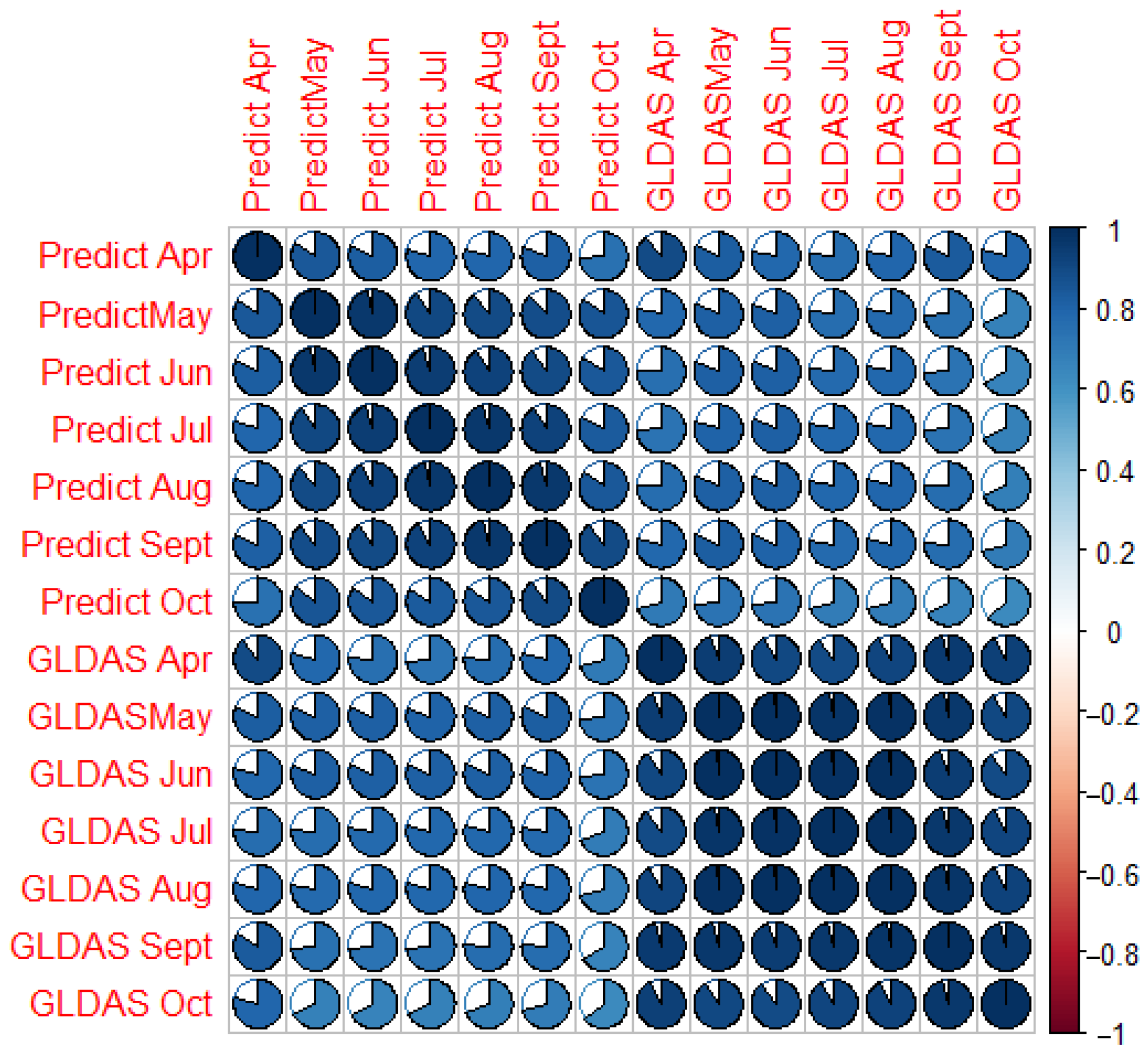

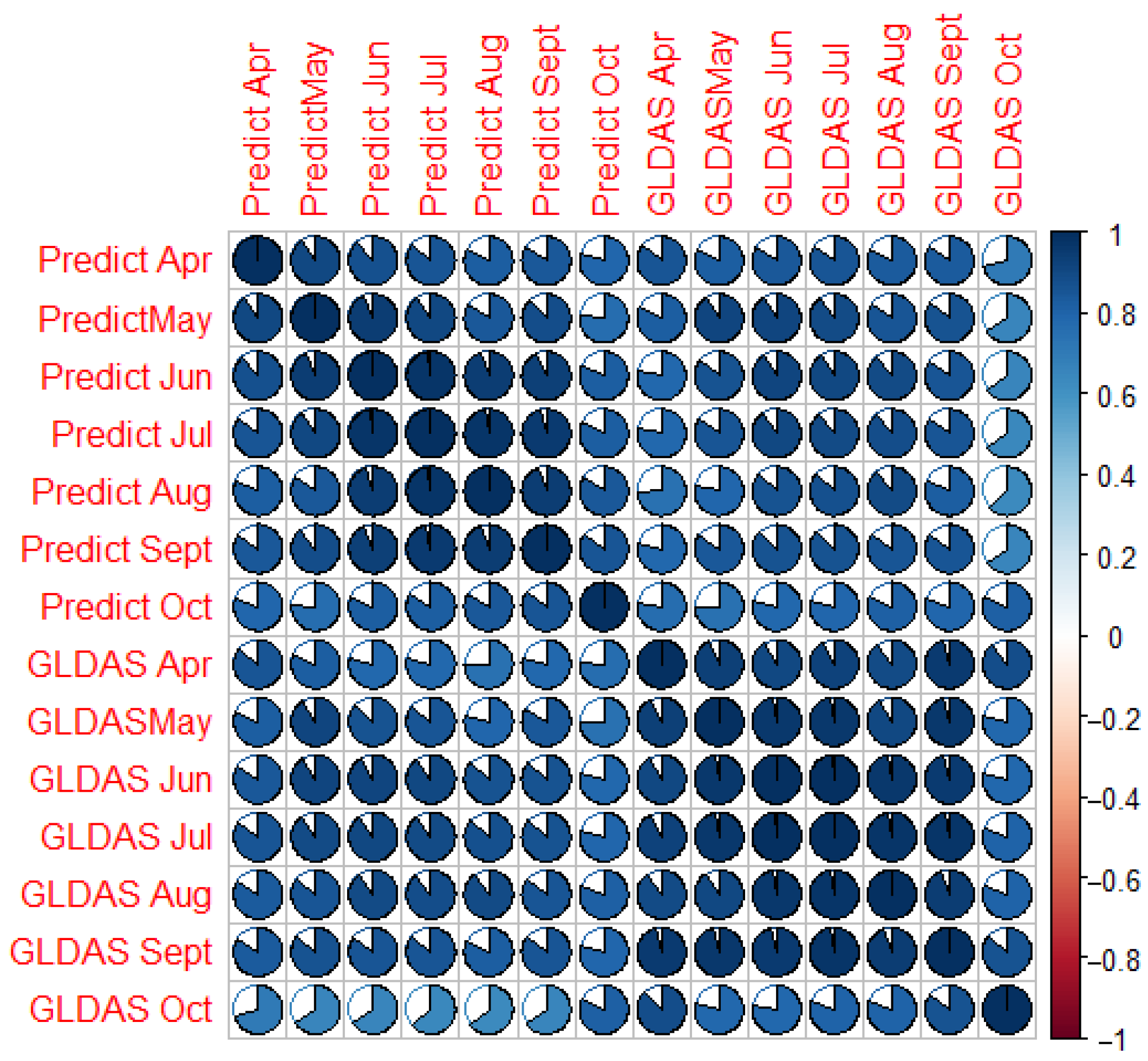
Appendix E

References
- Klein, C.; Taylor, C.M. Dry soils can intensify mesoscale convective systems. Proc. Natl. Acad. Sci. USA 2020, 117, 21132–21137. [Google Scholar] [CrossRef]
- Bi, H.; Ma, J.; Zheng, W.; Zeng, J. Comparison of soil moisture in GLDAS model simulations and in situ observations over the Tibetan Plateau. J. Geophys. Res. Atmos. 2016, 121, 2658–2678. [Google Scholar] [CrossRef]
- Hu, Z.; Chen, X.; Li, Y.; Zhou, Q.; Yin, G. Temporal and Spatial Variations of Soil Moisture Over Xinjiang Based on Multiple GLDAS Datasets. Front. Earth Sci. 2021, 9, 654848. [Google Scholar] [CrossRef]
- Ai, L.; Sun, S.; Li, S.; Ma, H. Research progress on the cooperative inversion of soil moisture using optical and SAR remote sensing. Remote Sens. Nat. Resour. 2021, 33, 10–18. [Google Scholar]
- Wang, J.J.; Ding, J.L.; Zhang, Z. Temporal-spatial dynamic change characteristics of soil moisture in Ebinur Lake Basin from 2008–2014. Acta Ecol. Sin. 2019, 39, 1784–1794. [Google Scholar]
- Bo, S.; Yong, L.; Mutian, H.; Yang, L.; Jiang, L.; Yu, Y. GNSS-IR soil moisture inversion method based on GA-SVM. J. Beijing Univ. Aeronaut. Astronaut. 2019, 45, 486–492. [Google Scholar] [CrossRef]
- Guo, F.; Chen, W.; Zhu, Y.; Zhang, X. A GNSS-IR soil moisture inversion method integrating phase, amplitude and frequency. Geomat. Inf. Sci. Wuhan Univ. 2022, 11. [Google Scholar] [CrossRef]
- Yang, Y.; Wang, Y. Soil Moisture Retrieval Using Multi-Temporal Sentinel-1 Sar Datasets in Zoige Wetland, China. In Proceedings of the IGARSS 2019—2019 IEEE International Geoscience and Remote Sensing Symposium, Yokohama, Japan, 28 July–2 August 2019; pp. 7093–7096. [Google Scholar]
- Wang, J.; Gao, T.; Li, R.; Yu, P.; Ma, Y.; Mi, N.; Wen, R.; Zhang, K. Research on soil moisture retrieval model based on optical remote sensing and microwave remote sensing. J. Meteorol. Environ. 2023, 39, 73–82. [Google Scholar] [CrossRef]
- Moreira, A.; Prats-Iraola, P.; Younis, M.; Krieger, G.; Hajnsek, I.; Papathanassiou, K.P. A tutorial on synthetic aperture radar. IEEE Geosci. Remote Sens. Mag. 2013, 1, 6–43. [Google Scholar] [CrossRef]
- Bindlish, R.; Barros, A.P. Parameterization of vegetation backscatter in radar-based, soil moisture estimation. Remote Sens. Environ. 2001, 76, 130–137. [Google Scholar] [CrossRef]
- Abowarda, A.S.; Bai, L.; Zhang, C.; Long, D.; Li, X.; Huang, Q.; Sun, Z. Generating surface soil moisture at 30 m spatial resolution using both data fusion and machine learning toward better water resources management at the field scale. Remote Sens. Environ. 2021, 255, 112301. [Google Scholar] [CrossRef]
- Zhu, X.; Song, X.; Leng, P.; Ronghai, H. Spatial downscaling of land surface temperature with the multi-scale geographically weighted regression. Natl. Remote Sens. Bull. 2021, 25, 1749–1766. [Google Scholar] [CrossRef]
- Peng, F.; Li, K.; Liang, R.; Li, X.; Zhang, P.; Yuan, Q.; Ji, Q.; Zhu, Z.; Wang, Y. Shallow lake water exchange process before and after water diversion projects as affected by wind field. J. Hydrol. 2021, 592, 125785. [Google Scholar] [CrossRef]
- Wang, J.; Ding, J.; Yu, D.; Ma, X.; Zhang, Z.; Ge, X.; Teng, D.; Li, X.; Liang, J.; Guo, Y.; et al. Machine learning-based detection of soil salinity in an arid desert region, Northwest China: A comparison between Landsat-8 OLI and Sentinel-2 MSI. Sci. Total. Environ. 2020, 707, 136092. [Google Scholar] [CrossRef]
- Wang, J.; Ding, J.; Yu, D.; Ma, X.; Zhang, Z.; Ge, X.; Teng, D.; Li, X.; Liang, J.; Lizaga, I.; et al. Capability of Sentinel-2 MSI data for monitoring and mapping of soil salinity in dry and wet seasons in the Ebinur Lake region, Xinjiang, China. Geoderma 2019, 353, 172–187. [Google Scholar] [CrossRef]
- Wang, X.; Zhang, F.; Ding, J.; Kung, H.-T.; Latif, A.; Johnson, V.C. Estimation of soil salt content (SSC) in the Ebinur Lake Wetland National Nature Reserve (ELWNNR), Northwest China, based on a Bootstrap-BP neural network model and optimal spectral indices. Sci. Total. Environ. 2018, 615, 918–930. [Google Scholar] [CrossRef]
- Paris, J. The effect of leaf size on the microwave backscattering by corn. Remote Sens. Environ. 1986, 19, 81–95. [Google Scholar] [CrossRef]
- Attema EP, W.; Ulaby, F.T. Vegetation modeled as a water cloud. Radio Sci. 1978, 13, 357–364. [Google Scholar] [CrossRef]
- Wang, E.; Wang, J.; Han, J.; Chen, L.; Xiang, J.; He, B.; Chen, J. Based on Sentinel-1 and Sentinel-2 Synergistic Inversion of Surface Soil Moisture in Arid Areas—A Case Study of the Middle and Lower Reaches of Golmud River. J. Salt Lake Res. 2022, 30, 16–24. [Google Scholar] [CrossRef]
- Jackson, T.J.; Chen, D.; Cosh, M.; Li, F.; Anderson, M.; Walthall, C.; Doriaswamy, P.; Hunt, E. Vegetation water content mapping using Landsat data derived normalized difference water index for corn and soybeans. Remote Sens. Environ. 2004, 92, 475–482. [Google Scholar] [CrossRef]
- Sawut, R.; Li, Y.; Kasimu, A.; Ablat, X. Examining the spatially varying effects of climatic and environmental pollution factors on the NDVI based on their spatially heterogeneous relationships in Bohai Rim, China. J. Hydrol. 2023, 617, 128815. [Google Scholar] [CrossRef]
- Yoo, C.; Im, J.; Park, S.; Cho, D. Spatial Downscaling of MODIS Land Surface Temperature: Recent Research Trends, Challenges, and Future Directions. J. Remote Sens. 2020, 36, 609–626. [Google Scholar]
- Ma, X.; Ji, Y.; Yuan, Y.; Van Oort, N.; Jin, Y.; Hoogendoorn, S. A comparison in travel patterns and determinants of user demand between docked and dockless bike-sharing systems using multi-sourced data. Transp. Res. Part A Policy Pract. 2020, 139, 148–173. [Google Scholar] [CrossRef]
- Kutner, M.H.; Nachtsheim, C.J.; Neter, J. Applied Linear Regression Models, 5th ed.; Semantic Scholar: Seattle, WA, USA, 2004. [Google Scholar]
- Moran, P.A.P. Notes on continuous stochastic phenomena. Biometrika 1950, 37, 17–23. [Google Scholar] [CrossRef]
- Pearson, K. Notes on the history of correlation. Biometrika 1920, 13, 25–45. [Google Scholar] [CrossRef]
- Wu, Y.; Sun, J.; Blanchette, M.; Rousseau, A.N.; Xu, Y.J.; Hu, B.; Zhang, G. Wetland mitigation functions on hydrological droughts: From drought characteristics to propagation of meteorological droughts to hydrological droughts. J. Hydrol. 2023, 617, 128971. [Google Scholar] [CrossRef]
- Yang, K.; Yu, Z.; Luo, Y.; Yang, Y.; Zhao, L.; Zhou, X. Spatial and temporal variations in the relationship between lake water surface temperatures and water quality—A case study of Dianchi Lake. Sci. Total. Environ. 2018, 624, 859–871. [Google Scholar] [CrossRef]
- Ge, X.; Ding, J.; Teng, D.; Wang, J.; Huo, T.; Jin, X.; Wang, J.; He, B.; Han, L. Updated soil salinity with fine spatial resolution and high accuracy: The synergy of Sentinel-2 MSI, environmental covariates and hybrid machine learning approaches. Catena 2022, 212, 106054. [Google Scholar] [CrossRef]
- Pebesma, E.J.; Wesseling, C.G. Gstat: A program for geostatistical modelling, prediction and simulation. Comput. Geosci. 1998, 24, 17–31. [Google Scholar] [CrossRef]
- Kumar, M.; Denis, D.M.; Suryavanshi, S. Long-term climatic trend analysis of Giridih district, Jharkhand (India) using statistical approach. Model. Earth Syst. Environ. 2016, 2, 116. [Google Scholar] [CrossRef]
- Yan, X.; Li, J.; Shao, Y.; Hu, Z.; Yang, Z.; Yin, S.; Cui, L. Driving forces of grassland vegetation changes in Chen Barag Banner, Inner Mongolia. GIScience Remote Sens. 2020, 57, 753–769. [Google Scholar] [CrossRef]
- Kendall, M.G. Rank Correlation Methods; Charles Griffin: London, UK, 1975. [Google Scholar]
- Mann, H.B. Non-parametric tests against trend. Economy 1945, 13, 245–259. [Google Scholar]
- Inoubli, R.; Constantino-Recillas, D.E.; Monsiváis-Huertero, A.; Farah, L.B.; Farah, I.R. Evaluation of Two Surface Scattering Models Within the Water Cloud Model Over an Agricultural Area in Mexico and Synergistic Use of Sentinel-1 and Sentinel-2 Images. In Proceedings of the IGARSS 2023—2023 IEEE International Geoscience and Remote Sensing Symposium, Pasadena, CA, USA, 16–21 July 2023; pp. 3213–3216. [Google Scholar]
- Liang, Y.; Lai, J.; Ren, C.; Ding, Q.; Shi, Y.; Hu, X.; Lu, X. Multi-Satellite Linear Regression Inversion Model for Soil Moisture Based on GNSS-IR Dual-System Combination. J. Geod. Geodyn. 2022, 42, 477–482. [Google Scholar]
- Zheng, N.; He, J.; Ding, R.; Zhang, H. A GNSS-IR Multi-system Combination Soil Moisture Estimation Method Based on Track Clustering. Geomat. Inf. Sci. Wuhan Univ. 2024, 49, 37–46. [Google Scholar] [CrossRef]
- Wang, R.; Ding, J.; Ge, X.; Wang, J.; Qin, S.; Tan, J.; Han, L.; Zhang, Z. Impacts of climate change on the wetlands in the arid region of Northwestern China over the past 2 decades. Ecol. Indic. 2023, 149, 110168. [Google Scholar] [CrossRef]
- Haijun, W.; Bin, Z.; Yaolin, L.; Yanfang, L.; Shan, X.; Yu, D.; Yuntai, Z.; Yuchen, C.; Song, H. Multi-dimensional analysis of urban expansion patterns and their driving forces based on the center of gravity-GTWR model: A case study of the Beijing-Tianjin-Hebei urban agglomeration. Acta Geogr. Sin. 2018, 73, 1076–1092. [Google Scholar] [CrossRef]
- Ni, F.; Wang, Q.; Shao, W.; Zhang, J.; Shan, Y.; Sun, X.; Guan, Q. Spatiotemporal characteristics and driving mechanisms of PM10 in arid and semi-arid cities of northwest China. J. Clean. Prod. 2023, 419, 138273. [Google Scholar] [CrossRef]
- Zhang, Y.; Fu, X.; Ding, Y.; Jiang, X.; Zhong, Q. The study of downscaling SMAP surface soil moisture in source region of Yellow River. J. China Hydrol. 2023. [Google Scholar]
- Wen, F.; Zhao, W.; Hu, L.; Xu, H.; Cui, Q. SMAP passive microwave soil moisture spatial downscaling based on optical remote sensing data: A case study in Shandian river basin. J. Remote Sens. 2021, 25, 962–973. [Google Scholar] [CrossRef]
- Song, M.; Xin, J.; Huang, S.; Chen, X. Microwave Soil Moisture Downscaling Study of Jilin Province Based on Geographically Weighted Regression Water Resources and Power. Hydropower Energy Sci. 2024, 4, 23–25. [Google Scholar]
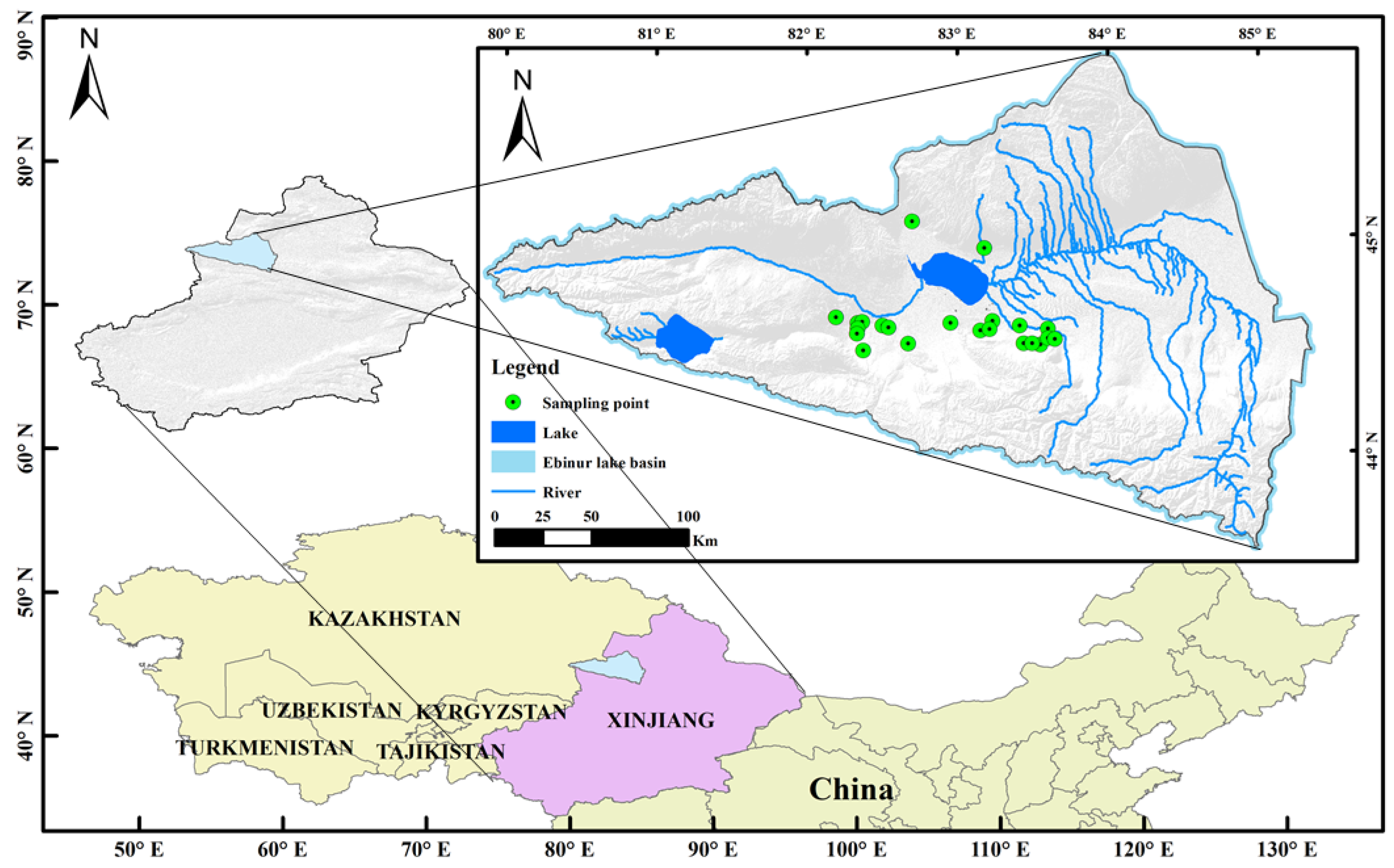
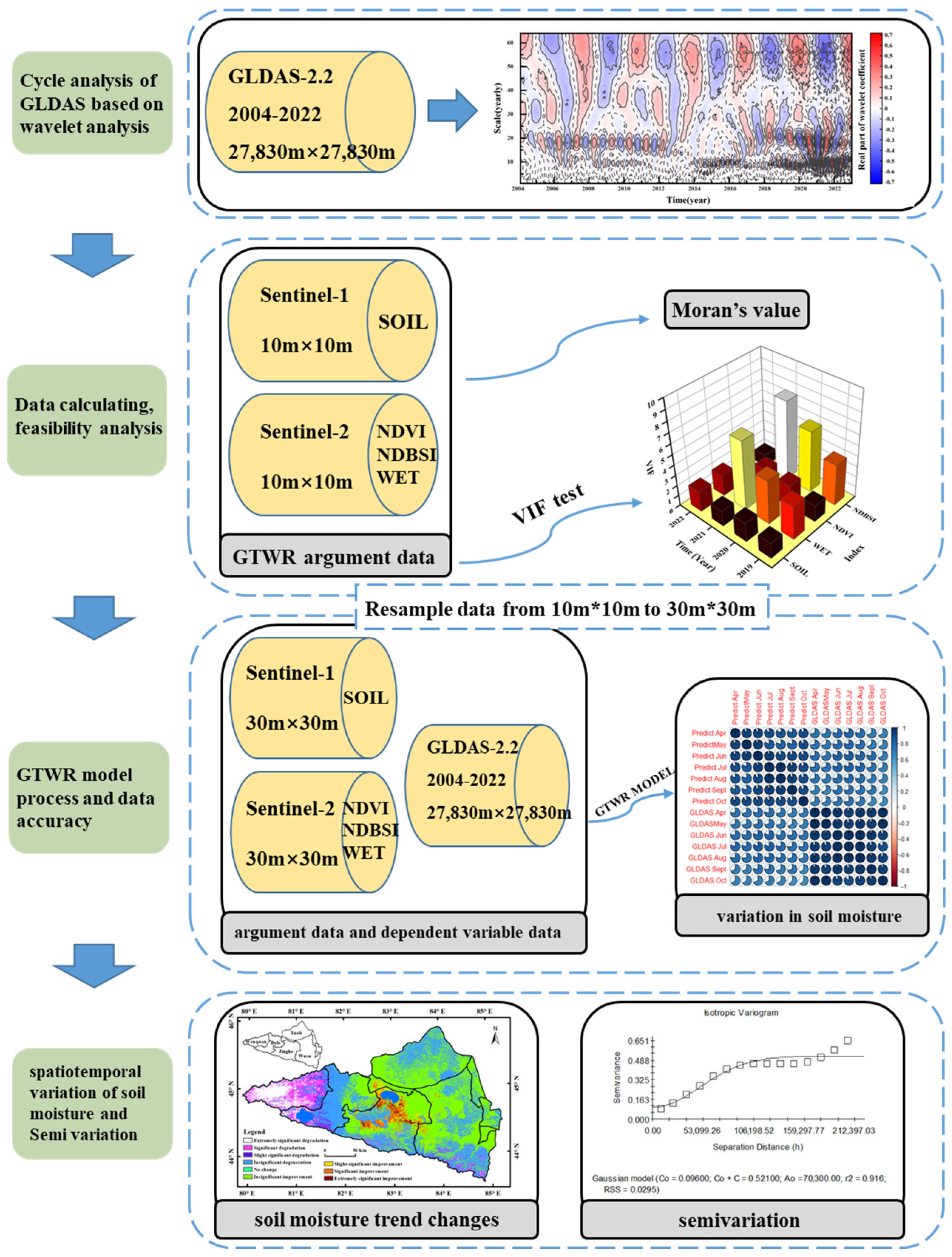

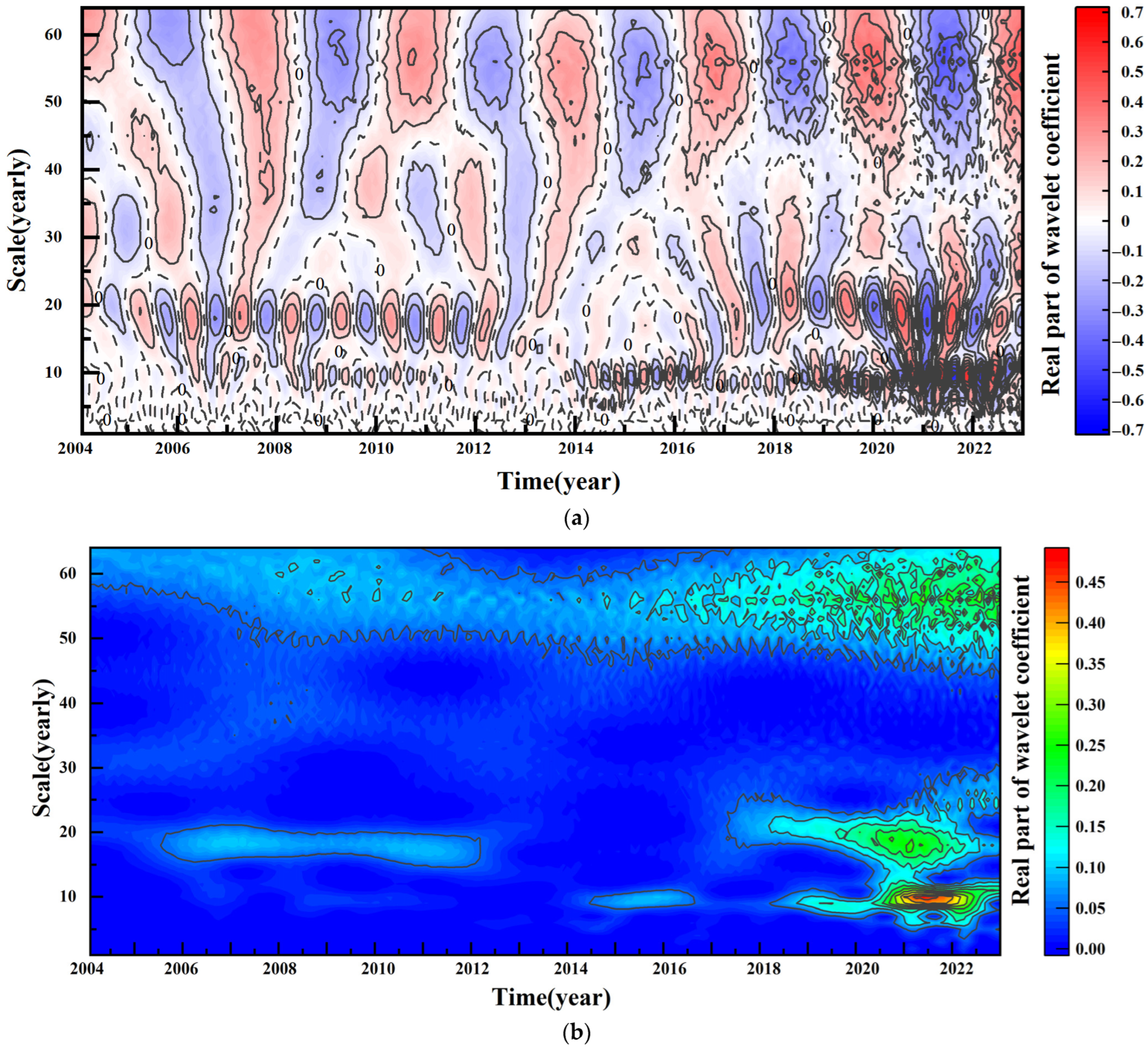
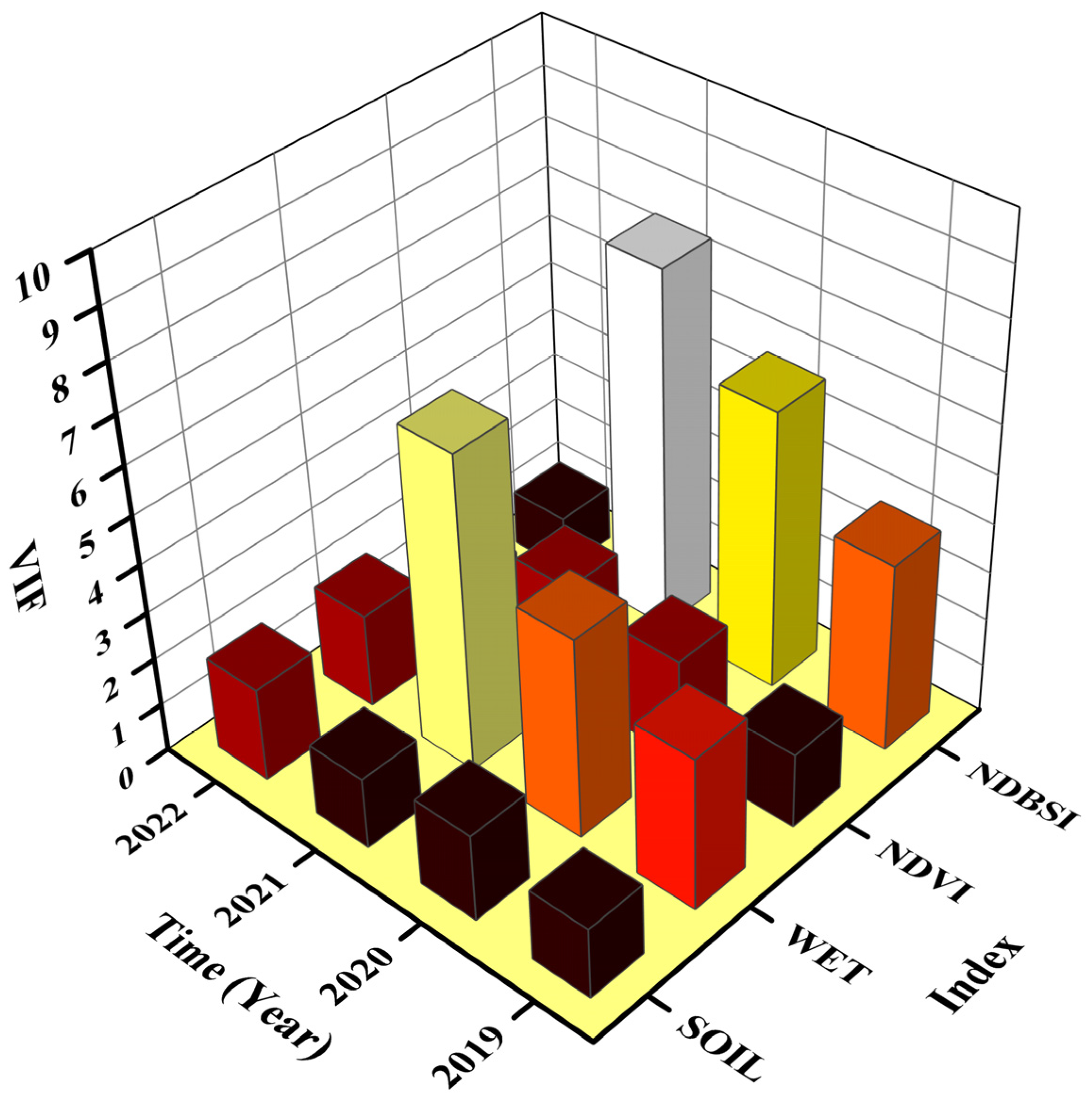
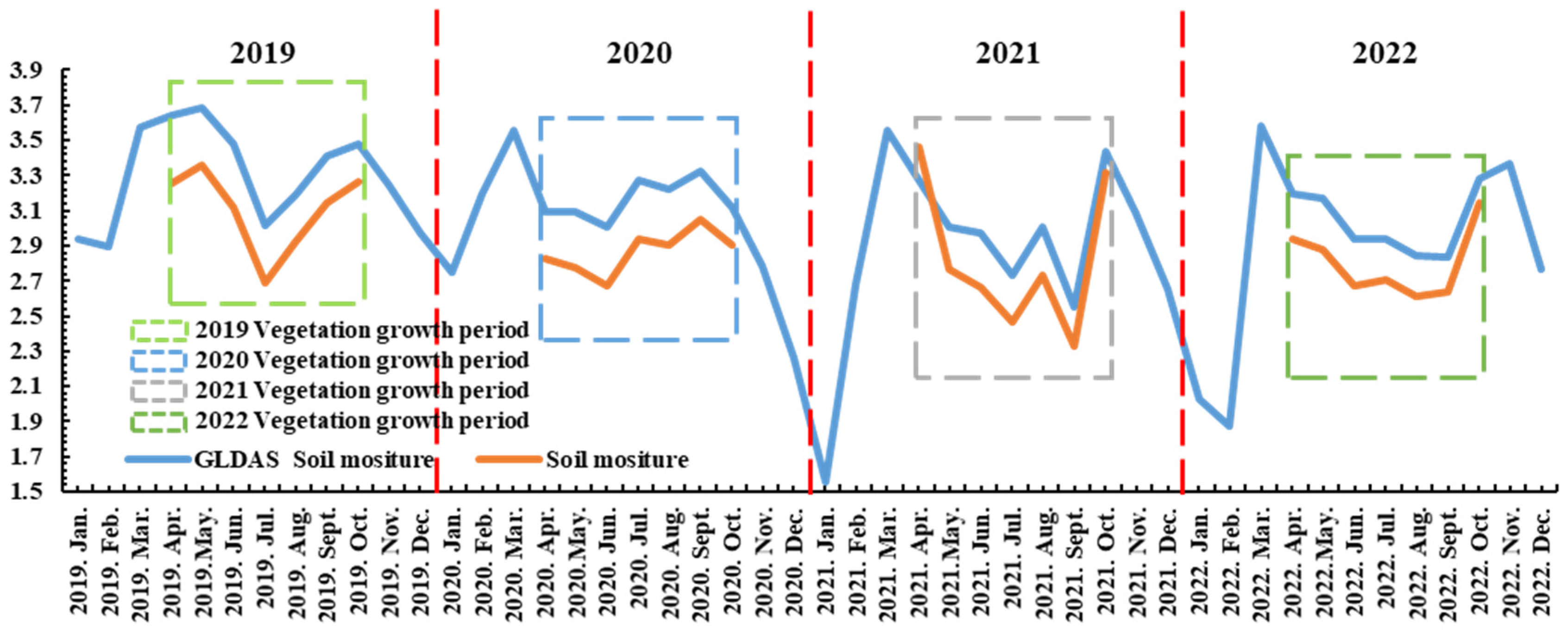


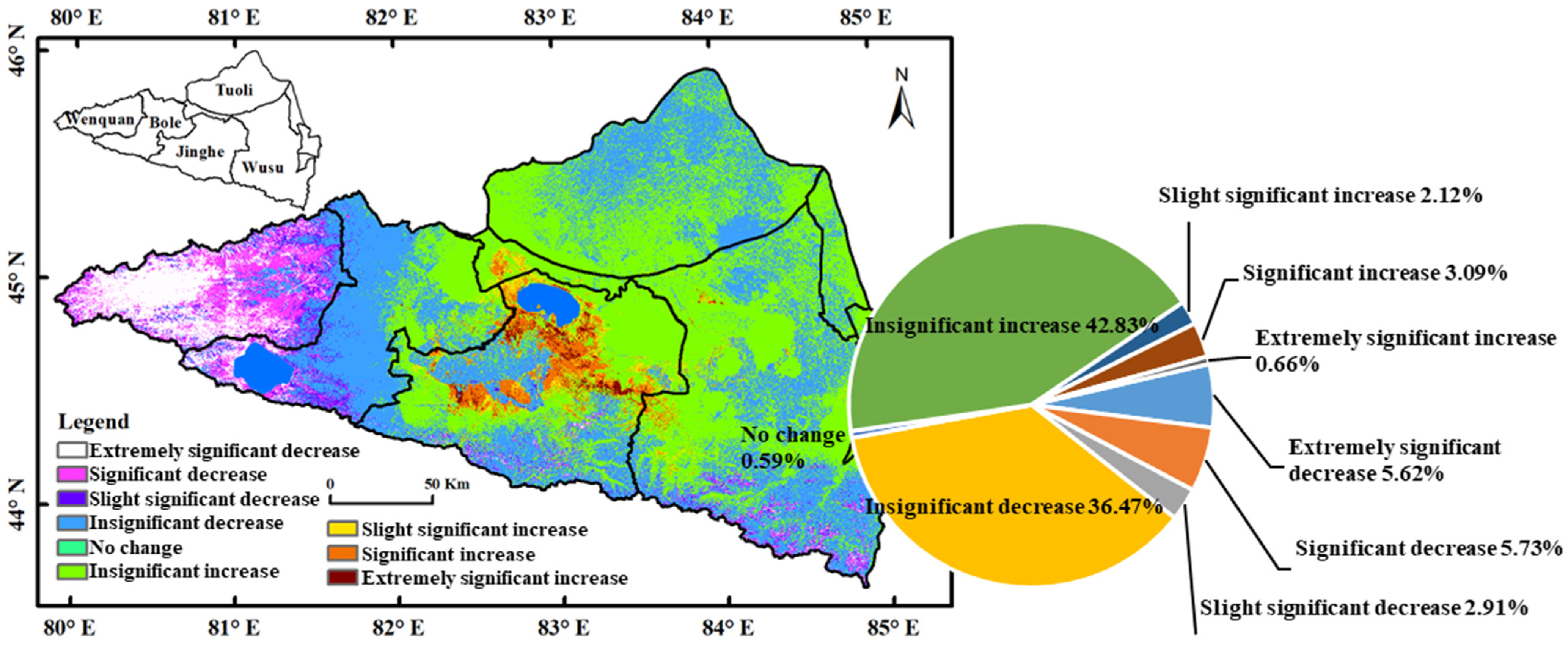
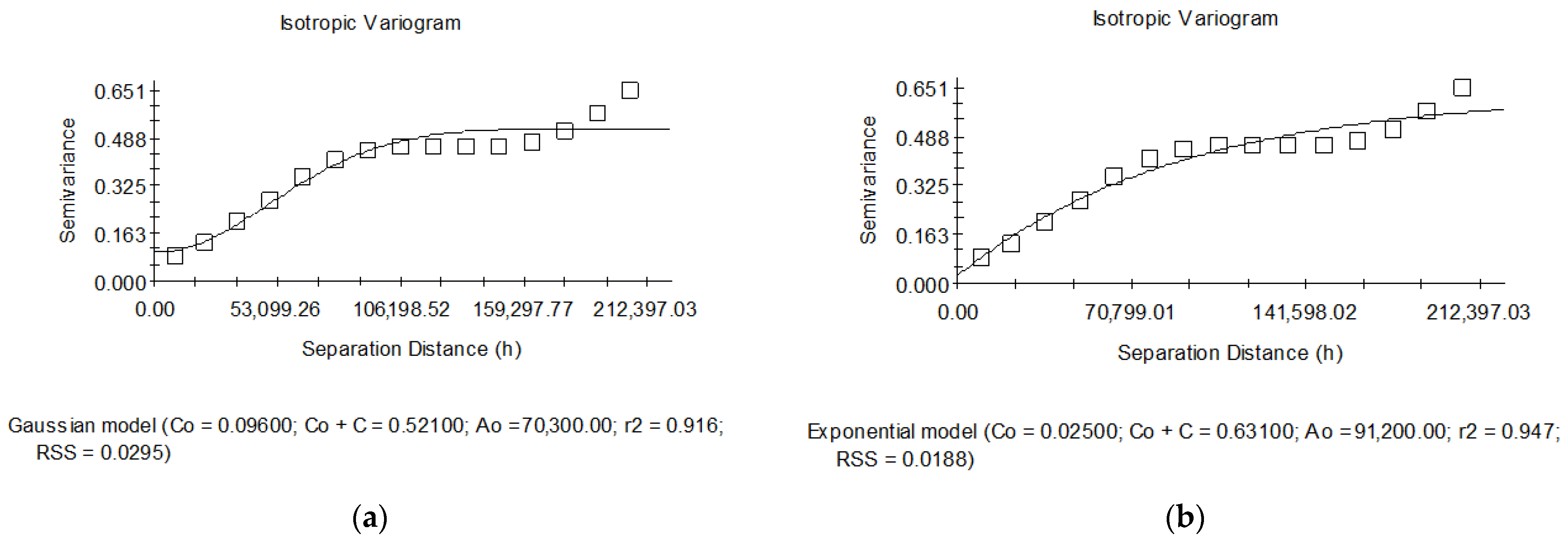


| Name | Min | Max | Scale | Bands | Source |
|---|---|---|---|---|---|
| Sentinel-1 | −50 | 1 | 10 | VV | https://sentinel.esa.int/web/sentinel/user-guides/sentinel-1-sar/, accessed on 1 October 2023 |
| Sentinel-2 | 10 | B4, B3, B2 | https://sentinel.esa.int/web/sentinel/user-guides/sentinel-2-msi/processing-levels/level-2, accessed on 1 October 2023 | ||
| GLDAS | 0.001389 | 9.56 | 0.0000275 | SoilMoist_S_tavg | NASA GES DISC at NASA Goddard Earth Sciences Data and information Services Center |
| MOD09A1 | −100 | 16,000 | 0.0001 | https://lpdaac.usgs.gov/products/mod09a1v006/, accessed on 1 October 2023 |
| Index | All-Landuses | Rangeland | Winter Wheat | Pasture |
|---|---|---|---|---|
| A | 0.0012 | 0.0009 | 0.0018 | 0.0014 |
| B | 0.091 | 0.032 | 0.138 | 0.084 |
| Apr. 2019 | May. 2019 | Jun. 2019 | Jul. 2019 | Aug. 2019 | Sep. 2019 | Oct. 2019 |
|---|---|---|---|---|---|---|
| Moran’s Index: 0.555310 | Moran’s Index: 0.617305 | Moran’s Index: 0.632113 | Moran’s Index: 0.620127 | Moran’s Index: 0.609430 | Moran’s Index: 0.578060 | Moran’s Index: 0.460031 |
| Expected Index: −0.000017 | Expected Index: −0.000017 | Expected Index: −0.000017 | Expected Index: −0.000017 | Expected Index: −0.000017 | Expected Index: −0.000017 | Expected Index: −0.000017 |
| Variance: 0.000009 | Variance: 0.000009 | Variance: 0.000009 | Variance: 0.000009 | Variance: 0.000009 | Variance: 0.000009 | Variance: 0.000009 |
| z-score: 187.484699 | z-score: 208.413339 | z-score: 213.410711 | z-score: 209.361468 | z-score: 205.750481 | z-score: 195.160900 | z-score: 155.314171 |
| p-value: 0.000000 | p-value: 0.000000 | p-value: 0.000000 | p-value: 0.000000 | p-value: 0.000000 | p-value: 0.000000 | p-value: 0.000000 |
Disclaimer/Publisher’s Note: The statements, opinions and data contained in all publications are solely those of the individual author(s) and contributor(s) and not of MDPI and/or the editor(s). MDPI and/or the editor(s) disclaim responsibility for any injury to people or property resulting from any ideas, methods, instructions or products referred to in the content. |
© 2024 by the authors. Licensee MDPI, Basel, Switzerland. This article is an open access article distributed under the terms and conditions of the Creative Commons Attribution (CC BY) license (https://creativecommons.org/licenses/by/4.0/).
Share and Cite
Xiao, H.; Wang, J.; Ding, J.; Li, X.; Chen, K. Downscale Inversion of Soil Moisture during Vegetation Growth Period in Ebinur Lake Watershed. Remote Sens. 2024, 16, 983. https://doi.org/10.3390/rs16060983
Xiao H, Wang J, Ding J, Li X, Chen K. Downscale Inversion of Soil Moisture during Vegetation Growth Period in Ebinur Lake Watershed. Remote Sensing. 2024; 16(6):983. https://doi.org/10.3390/rs16060983
Chicago/Turabian StyleXiao, Hongzhi, Jinjie Wang, Jianli Ding, Xiang Li, and Keyu Chen. 2024. "Downscale Inversion of Soil Moisture during Vegetation Growth Period in Ebinur Lake Watershed" Remote Sensing 16, no. 6: 983. https://doi.org/10.3390/rs16060983




